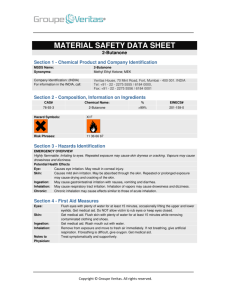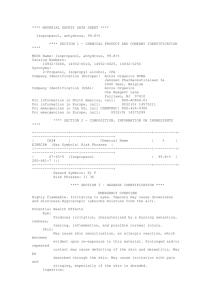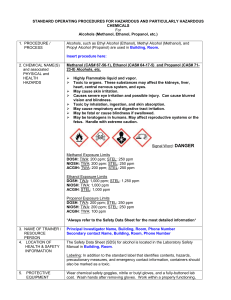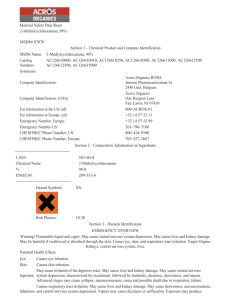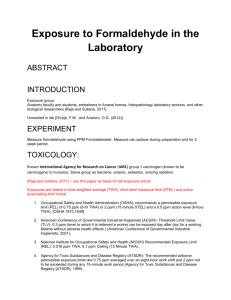Material Safety Data Sheet 1-Butanol ACC# 15400 Section 1
advertisement
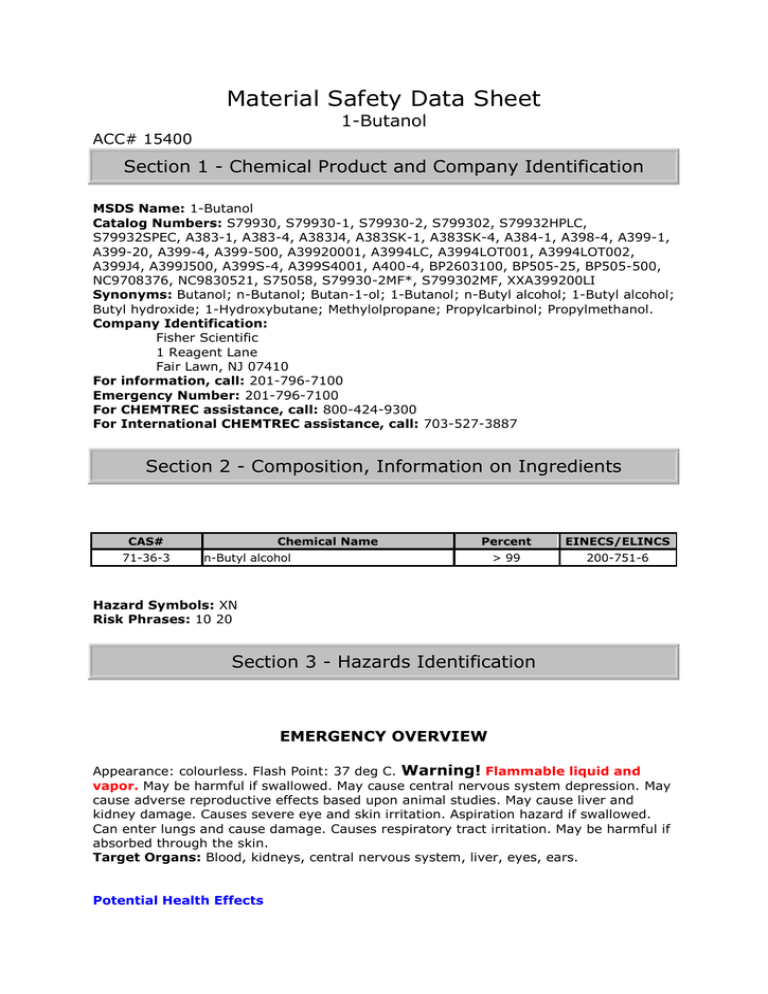
Material Safety Data Sheet 1-Butanol ACC# 15400 Section 1 - Chemical Product and Company Identification MSDS Name: 1-Butanol Catalog Numbers: S79930, S79930-1, S79930-2, S799302, S79932HPLC, S79932SPEC, A383-1, A383-4, A383J4, A383SK-1, A383SK-4, A384-1, A398-4, A399-1, A399-20, A399-4, A399-500, A39920001, A3994LC, A3994LOT001, A3994LOT002, A399J4, A399J500, A399S-4, A399S4001, A400-4, BP2603100, BP505-25, BP505-500, NC9708376, NC9830521, S75058, S79930-2MF*, S799302MF, XXA399200LI Synonyms: Butanol; n-Butanol; Butan-1-ol; 1-Butanol; n-Butyl alcohol; 1-Butyl alcohol; Butyl hydroxide; 1-Hydroxybutane; Methylolpropane; Propylcarbinol; Propylmethanol. Company Identification: Fisher Scientific 1 Reagent Lane Fair Lawn, NJ 07410 For information, call: 201-796-7100 Emergency Number: 201-796-7100 For CHEMTREC assistance, call: 800-424-9300 For International CHEMTREC assistance, call: 703-527-3887 Section 2 - Composition, Information on Ingredients CAS# 71-36-3 Chemical Name Percent EINECS/ELINCS > 99 200-751-6 n-Butyl alcohol Hazard Symbols: XN Risk Phrases: 10 20 Section 3 - Hazards Identification EMERGENCY OVERVIEW Appearance: colourless. Flash Point: 37 deg C. Warning! Flammable liquid and vapor. May be harmful if swallowed. May cause central nervous system depression. May cause adverse reproductive effects based upon animal studies. May cause liver and kidney damage. Causes severe eye and skin irritation. Aspiration hazard if swallowed. Can enter lungs and cause damage. Causes respiratory tract irritation. May be harmful if absorbed through the skin. Target Organs: Blood, kidneys, central nervous system, liver, eyes, ears. Potential Health Effects Eye: Causes severe eye irritation. May cause corneal edema and inflammation. May cause lacrimation (tearing), blurred vision, and photophobia. Vapors appear to cause a special vacuolar keratopathy in humans. Skin: Causes severe skin irritation. May be harmful if absorbed through the skin. Repeated or prolonged exposure may cause drying and cracking of the skin. Ingestion: Causes gastrointestinal irritation with nausea, vomiting and diarrhea. May cause systemic toxicity with acidosis. May cause central nervous system depression, characterized by excitement, followed by headache, dizziness, drowsiness, and nausea. Advanced stages may cause collapse, unconsciousness, coma and possible death due to respiratory failure. May be harmful if swallowed. Aspiration may be fatal. May be absorbed from the gastrointestinal tract. Inhalation: Causes respiratory tract irritation. May cause cardiovascular disturbances, hearing abnormalities, central nervous system depression, muscle weakness, and possible death due to respiratory failure. May be absorbed through the lungs. Chronic: Prolonged or repeated skin contact may cause defatting and dermatitis. May cause reproductive and fetal effects. Laboratory experiments have resulted in mutagenic effects. Prolonged exposure may cause liver, kidney, and heart damage. May cause damage to the auditory nerve (some hearing loss) and vestibular injury. Section 4 - First Aid Measures Eyes: Immediately flush eyes with plenty of water for at least 15 minutes, occasionally lifting the upper and lower eyelids. Get medical aid immediately. Skin: Get medical aid. Flush skin with plenty of soap and water for at least 15 minutes while removing contaminated clothing and shoes. Wash clothing before reuse. Ingestion: Do NOT induce vomiting. If victim is conscious and alert, give 2-4 cupfuls of milk or water. Never give anything by mouth to an unconscious person. Possible aspiration hazard. Get medical aid immediately. Wash mouth out with water. Inhalation: Remove from exposure to fresh air immediately. If breathing is difficult, give oxygen. Get medical aid. Do NOT use mouth-to-mouth resuscitation. If breathing has ceased apply artificial respiration using oxygen and a suitable mechanical device such as a bag and a mask. Notes to Physician: Alcoholic beverage consumption may enhance the toxic effects of this substance. Persons with liver, kidney, or central nervous system diseases may be at increased risk from exposure to this product. Butanol is especially toxic if aspirated. Treat symptomatically and supportively. Section 5 - Fire Fighting Measures General Information: As in any fire, wear a self-contained breathing apparatus in pressure-demand, MSHA/NIOSH (approved or equivalent), and full protective gear. Vapors may form an explosive mixture with air. Vapors can travel to a source of ignition and flash back. Use water spray to keep fire-exposed containers cool. Flammable liquid and vapor. Vapors may be heavier than air. They can spread along the ground and collect in low or confined areas. May be ignited by heat, sparks, and flame. Containers may explode when heated. Extinguishing Media: For small fires, use dry chemical, carbon dioxide, water spray or alcohol-resistant foam. For large fires, use water spray, fog, or alcohol-resistant foam. Use water spray to cool fire-exposed containers. Water may be ineffective. Do NOT use straight streams of water. Cool containers with flooding quantities of water until well after fire is out. Section 6 - Accidental Release Measures General Information: Use proper personal protective equipment as indicated in Section 8. Spills/Leaks: Avoid runoff into storm sewers and ditches which lead to waterways. Remove all sources of ignition. Absorb spill using an absorbent, non-combustible material such as earth, sand, or vermiculite. Do not use combustible materials such as saw dust. Provide ventilation. A vapor suppressing foam may be used to reduce vapors. Water spray may reduce vapor but may not prevent ignition in closed spaces. Section 7 - Handling and Storage Handling: Wash thoroughly after handling. Remove contaminated clothing and wash before reuse. Use only in a well-ventilated area. Ground and bond containers when transferring material. Use spark-proof tools and explosion proof equipment. Avoid contact with eyes, skin, and clothing. Empty containers retain product residue, (liquid and/or vapor), and can be dangerous. Avoid contact with heat, sparks and flame. Do not ingest or inhale. Do not pressurize, cut, weld, braze, solder, drill, grind, or expose empty containers to heat, sparks or open flames. Storage: Keep away from heat, sparks, and flame. Keep away from sources of ignition. Store in a tightly closed container. Store in a cool, dry, well-ventilated area away from incompatible substances. Store protected from explosives, organic peroxides, poisons, and radioactive materials. Section 8 - Exposure Controls, Personal Protection Engineering Controls: Facilities storing or utilizing this material should be equipped with an eyewash facility and a safety shower. Use adequate general or local exhaust ventilation to keep airborne concentrations below the permissible exposure limits. Exposure Limits Chemical Name n-Butyl alcohol ACGIH (skin) - potential for cutaneous absorption; (C 50 ppm) NIOSH OSHA - Final PELs 1400 ppm IDLH (10 percent lower explosive limit) 100 ppm TWA; 300 mg/m3 TWA OSHA Vacated PELs: n-Butyl alcohol: C 50 ppm; C 150 mg/m3 Personal Protective Equipment Eyes: Wear appropriate protective eyeglasses or chemical safety goggles as described by OSHA's eye and face protection regulations in 29 CFR 1910.133 or European Standard EN166. Skin: Wear appropriate protective gloves to prevent skin exposure. Clothing: Wear appropriate protective clothing to prevent skin exposure. Respirators: A respiratory protection program that meets OSHA's 29 CFR §1910.134 and ANSI Z88.2 requirements or European Standard EN 149 must be followed whenever workplace conditions warrant a respirator's use. Section 9 - Physical and Chemical Properties Physical State: Liquid Appearance: colourless Odor: sweetish odor - putrid odor - fusel oil odor pH: Not available. Vapor Pressure: 6.5 mm Hg @ 25 deg C Vapor Density: 2.6 (Air=1) Evaporation Rate:0.46 (Butyl acetate=1) Viscosity: 2.94 cP at 20 deg C Boiling Point: 117.4 deg C Freezing/Melting Point:-90 deg C Autoignition Temperature: 343 deg C ( 649.40 deg F) Flash Point: 37 deg C ( 98.60 deg F) Decomposition Temperature:Not available. NFPA Rating: (estimated) Health: 1; Flammability: 3; Reactivity: 0 Explosion Limits, Lower:1.4 vol % Upper: 11.2 vol % Solubility: Soluble. Specific Gravity/Density:0.810 (Water=1) Molecular Formula:CH3(CH2)2CH2OH Molecular Weight:74.12 Section 10 - Stability and Reactivity Chemical Stability: Stable under normal temperatures and pressures. Conditions to Avoid: Incompatible materials, ignition sources, excess heat. Incompatibilities with Other Materials: Oxidizing agents, reducing agents, acid chlorides, alkali metals, aluminum, copper, copper alloys, halogens, organic peroxides, acid anhydrides, chromium trioxide, mineral acids. Hazardous Decomposition Products: Carbon monoxide, irritating and toxic fumes and gases, carbon dioxide. Hazardous Polymerization: Will not occur. Section 11 - Toxicological Information RTECS#: CAS# 71-36-3: EO1400000 LD50/LC50: CAS# 71-36-3: Draize test, rabbit, eye: 2 mg Severe; Draize test, rabbit, eye: 2 mg/24H Severe; Draize test, rabbit, skin: 405 mg/24H Moderate; Draize test, rabbit, skin: 20 mg/24H Moderate; Inhalation, rat: LC50 = 8000 ppm/4H; Oral, mouse: LD50 = 2680 mg/kg; Oral, rabbit: LD50 = 3484 mg/kg; Oral, rat: LD50 = 790 mg/kg; Skin, rabbit: LD50 = 3400 mg/kg;<BR. Carcinogenicity: CAS# 71-36-3: Not listed by ACGIH, IARC, NIOSH, NTP, or OSHA. Epidemiology: Mutation data has been reported. Teratogenicity: Oral, rat: TDLo = 35295 mg/kg (female 1-15 day(s) after conception) Effects on Embryo or Fetus - fetotoxicity (except death, e.g., stunted fetus) and Effects on Newborn - biochemical and metabolic.; Inhalation, rat: TCLo = 8000 ppm/7H (female 1-19 day(s) after conception) Specific Developmental Abnormalities - musculoskeletal system. Reproductive Effects: Oral, rat: TDLo = 35295 mg/kg (female 1-15 day(s) after conception) Fertility - female fertility index (e.g. # females pregnant per # sperm positive females; # females pregnant per # females mated) and pre-implantation mortality (e.g. reduction in number of implants per female; total number of implants per corpora lutea)and post-implantation mortality (e.g. dead and/or resorbed implants per total number of implants). Neurotoxicity: No information available. Mutagenicity: Sex Chromosome Loss and Nondisjunction: Aspergillus nidulans = 7000 ppm.; Sex Chromosome Loss and Nondisjunction: Hamster, Lung = 100 mmol/L. Other Studies: None. Section 12 - Ecological Information Ecotoxicity: Fish: Fathead Minnow: LC50 = 1510-1730 mg/L; 96 Hr; Static bioassay at 24.7°C (pH 7.64) flea Daphnia: EC50 = 1980-1983 mg/L; 48 Hr; Unspecified ria: Phytobacterium phosphoreum: EC50 = 2817-3710 mg/L; 5,30 min; Microtox test Release of n-butanol to soil may result in volatilization from the soil surface and biodegradation is expected to be significant. n-Butanol should not bind strongly to soil and so is expected to leach into groundwater. Release of n-butanol to water is expected to result in biodegradation and in volatilization from the water surface. Photooxidation by hydroxyl radicals is expected to be slow. Environmental: When released to soil, substance is expected to biodegrade, leach to ground water or volatilize. In water, substance is expected to biodegrade or volatilize. Bioconcentration potential is predicted to be low. Soil Mobility: Substance is moderately to highly mobile (log octanol/ water partition coefficient=0.88). Physical: Substance reacts in air with hydroxyl radicals (half-life=2.3 days). Other: None. Section 13 - Disposal Considerations Chemical waste generators must determine whether a discarded chemical is classified as a hazardous waste. US EPA guidelines for the classification determination are listed in 40 CFR Parts 261.3. Additionally, waste generators must consult state and local hazardous waste regulations to ensure complete and accurate classification. RCRA P-Series: None listed. RCRA U-Series: CAS# 71-36-3: waste number U031; (Ignitable waste). Section 14 - Transport Information US DOT IATA RID/ADR IMO Shipping Name: BUTANOL Hazard Class: UN Number: 3 Canada TDG BUTANOLS 3 UN1120 Packing Group: III UN1120 III FLASHPOINT 29 C Additional Info: Section 15 - Regulatory Information US FEDERAL TSCA CAS# 71-36-3 is listed on the TSCA inventory. Health & Safety Reporting List None of the chemicals are on the Health & Safety Reporting List. Chemical Test Rules None of the chemicals in this product are under a Chemical Test Rule. Section 12b None of the chemicals are listed under TSCA Section 12b. TSCA Significant New Use Rule None of the chemicals in this material have a SNUR under TSCA. SARA Section 302 (RQ) CAS# 71-36-3: final RQ = 5000 pounds (2270 kg) Section 302 (TPQ) None of the chemicals in this product have a TPQ. SARA Codes CAS # 71-36-3: acute, flammable. Section 313 This material contains n-Butyl alcohol (CAS# 71-36-3, 99%),which is subject to the reporting requirements of Section 313 of SARA Title III and 40 CFR Part 373. Clean Air Act: This material does not contain any hazardous air pollutants. This material does not contain any Class 1 Ozone depletors. This material does not contain any Class 2 Ozone depletors. Clean Water Act: None of the chemicals in this product are listed as Hazardous Substances under the CWA. None of the chemicals in this product are listed as Priority Pollutants under the CWA. None of the chemicals in this product are listed as Toxic Pollutants under the CWA. OSHA: None of the chemicals in this product are considered highly hazardous by OSHA. STATE CAS# 71-36-3 can be found on the following state right to know lists: California, New Jersey, Florida, Pennsylvania, Minnesota, Massachusetts. California No Significant Risk Level: None of the chemicals in this product are listed. European/International Regulations European Labeling in Accordance with EC Directives Hazard Symbols: XN Risk Phrases: R 10 Flammable. R 20 Harmful by inhalation. Safety Phrases: S 16 Keep away from sources of ignition - No smoking. WGK (Water Danger/Protection) CAS# 71-36-3: 1 Canada CAS# 71-36-3 is listed on Canada's DSL List. CAS# 71-36-3 is listed on Canada's DSL List. This product has a WHMIS classification of B2, D2A. CAS# 71-36-3 is listed on Canada's Ingredient Disclosure List. Exposure Limits CAS# 71-36-3: OEL-AUSTRALIA:TWA 50 ppm (150 mg/m3);Skin OEL-AUSTRIA :TWA 100 ppm (300 mg/m3) OEL-BELGIUM:STEL 50 ppm (152 mg/m3);Skin OE L-CZECHOSLOVAKIA:TWA 100 mg/m3;STEL 200 mg/m3 OEL-DENMARK:STEL 50 ppm (150 mg/m3);Skin OEL-FINLAND:TWA 50 ppm (150 mg/m3);STEL 75 ppm (225 mg/m3);Skin OEL-FRANCE:STEL 50 ppm (150 mg/m3) OEL-GERMANY:TWA 100 ppm (300 mg/m3) OEL-HUNGARY:TWA 100 mg/m3;STEL 200 mg/m3;Skin OEL-IN DIA:TWA 50 ppm (150 mg/m3);Skin OEL-JAPAN:STEL 50 ppm (150 mg/m3);Ski n OEL-THE NETHERLANDS:TWA 50 ppm (150 mg/m3);Skin OEL-THE PHILIPPINE S:TWA 100 ppm (300 mg/m3) OEL-RUSSIA:STEL 50 ppm (10 mg/m3) OEL-SWED EN:TWA 15 ppm (45 mg/m3);STEL 30 ppm (90 mg/m3);Skin OEL-SWITZERLAND: TWA 50 ppm (150 mg/m3);STEL 100 ppm;Skin OEL-TURKEY:TWA 100 ppm (300 mg/m3) OEL-UNITED KINGDOM:TWA 50 ppm (150 mg/m3);STEL 50 ppm;Skin OE L IN BULGARIA, COLOMBIA, JORDAN, KOREA check ACGIH TLV OEL IN NEW ZEA LAND, SINGAPORE, VIETNAM check ACGI TLV Section 16 - Additional Information MSDS Creation Date: 6/10/1999 Revision #5 Date: 7/10/2001 The information above is believed to be accurate and represents the best information currently available to us. However, we make no warranty of merchantability or any other warranty, express or implied, with respect to such information, and we assume no liability resulting from its use. Users should make their own investigations to determine the suitability of the information for their particular purposes. In no event shall Fisher be liable for any claims, losses, or damages of any third party or for lost profits or any special, indirect, incidental, consequential or exemplary damages, howsoever arising, even if Fisher has been advised of the possibility of such damages.
